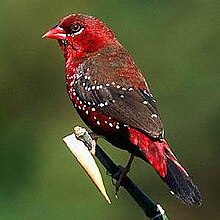Amandava is a genus of the estrildid finches. These birds are found in dense grass or scrub in Africa and South Asia. They are gregarious seed-eaters with short, red bills. In earlier literature, amadavat and amidavad have been used.[2] The name amandava, along with amadavat and amidavad are all corruptions of Ahmedabad, a city in Gujarat, India from where the first few specimens of the red munia Amandava amandava were obtained.[3]
| Amandava | |
|---|---|

| |
| Male red avadavat (Amandava amandava) | |
| Scientific classification | |
| Domain: | Eukaryota |
| Kingdom: | Animalia |
| Phylum: | Chordata |
| Class: | Aves |
| Order: | Passeriformes |
| Family: | Estrildidae |
| Genus: | Amandava Blyth, 1836 |
| Type species | |
| Amandava punctata = Fringilla amandava[1] Blyth, 1836
| |
| Species | |
|
A. amandava | |
Taxonomy edit
The genus Amandava was introduced in 1836 by the English zoologist Edward Blyth for the red avadavat. The genus in mentioned in a footnote to a page of an edition of Gilbert White's The Natural History and Antiquities of Selborne that Blythe edited.[4] The name is derived by tautomony with the binomial name Fringilla amandava introduced for the red avadavat by Carl Linnaeus in 1758. The word amandava is a corruption of Ahmedabad, a city in the Indian state of Gujarat.[5] The genus Amandava is sister to the genus Amadiva containing two African finches.[6]
Species edit
The genus contains three species:[7]
| Common name | Scientific name and subspecies | Range | Size and ecology | IUCN status and estimated population |
|---|---|---|---|---|
| Red avadavat or red munia | Amandava amandava (Linnaeus, 1758) |
Bangladesh, India, Nepal and Pakistan | Size: Habitat: Diet: |
LC
|
| Green avadavat or green munia | Amandava formosa (Latham, 1790) |
central India, around southern Rajasthan, specifically around Oriya village, central Uttar Pradesh, southern Bihar and West Bengal |
Size: Habitat: Diet: |
VU
|
| Orange-breasted waxbill or zebra waxbill | Amandava subflava (Vieillot, 1819) |
south of the Sahara in Africa | Size: Habitat: Diet: |
LC
|
The two avadavats, which are very closely related, are found in tropical South Asia, and the waxbill in Africa. Various members of this genus are sometimes placed in Sporaeginthus.
References edit
- ^ "Estrildidae". aviansystematics.org. The Trust for Avian Systematics. Retrieved 2023-07-16.
- ^ Newton, A. & H. Gadow. 1896. A dictionary of birds. Black.London. p.11
- ^ a b Pittie, Aasheesh (2004). "A dictionary of scientific bird names originating from the Indian region". Buceros. 9 (2): 1–30.
- ^ White, Gilbert (1836). Blyth, Edward (ed.). The Natural History of Selborne, with its Antiquites; Naturalist's Calendar, &c. London: Orr and Smith. p. 44, Footnote.
- ^ Jobling, James A. (2010). The Helm Dictionary of Scientific Bird Names. London: Christopher Helm. p. 43. ISBN 978-1-4081-2501-4.
- ^ Olsson, Urban; Alström, Per (2020). "A comprehensive phylogeny and taxonomic evaluation of the waxbills (Aves: Estrildidae)". Molecular Phylogenetics and Evolution. 146: 106757. doi:10.1016/j.ympev.2020.106757. PMID 32028027.
- ^ Gill, Frank; Donsker, David; Rasmussen, Pamela, eds. (July 2021). "Waxbills, parrotfinches, munias, whydahs, Olive Warbler, accentors, pipits". IOC World Bird List Version 11.2. International Ornithologists' Union. Retrieved 14 July 2021.
- Clement, Harris and Davis, Finches and Sparrows ISBN 0-7136-8017-2